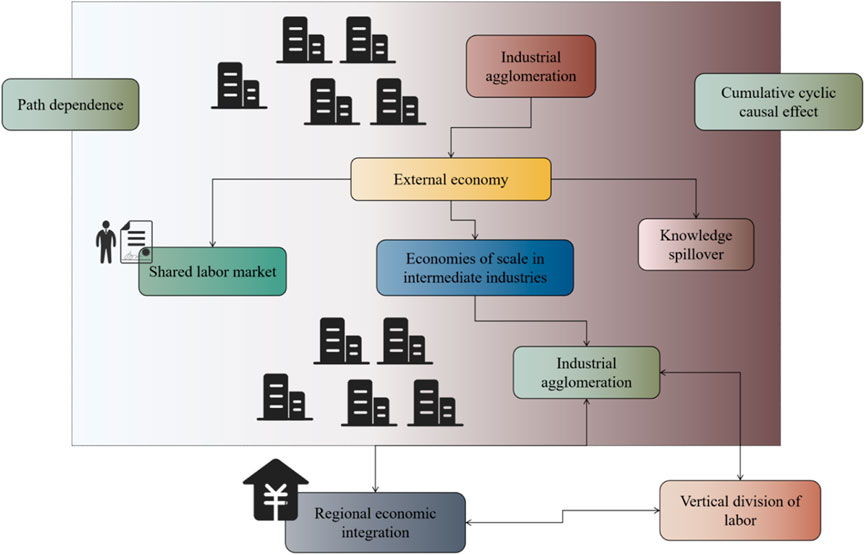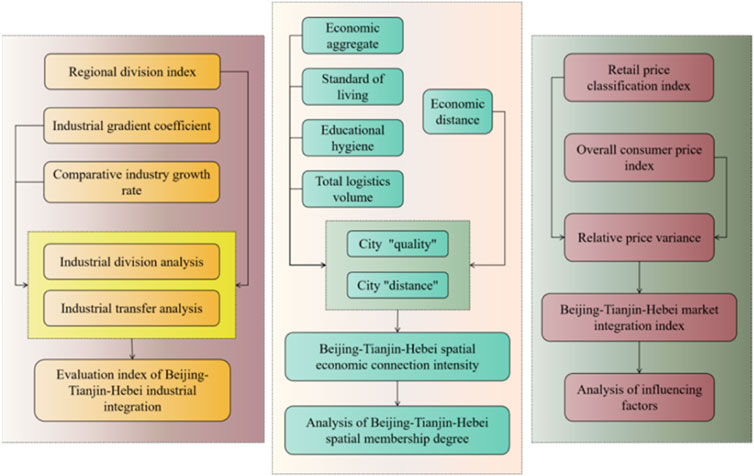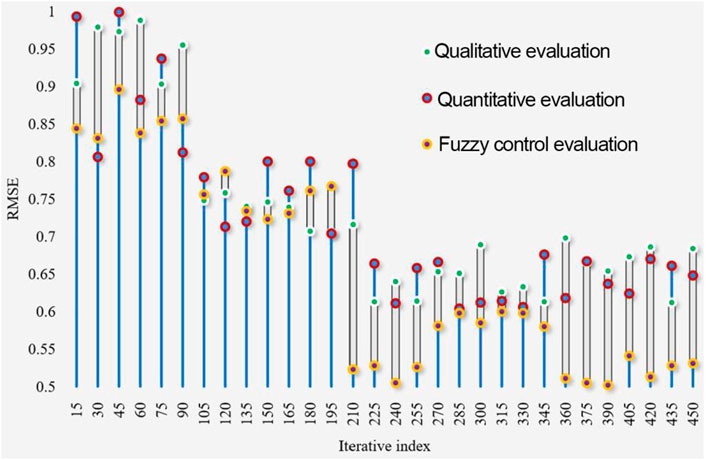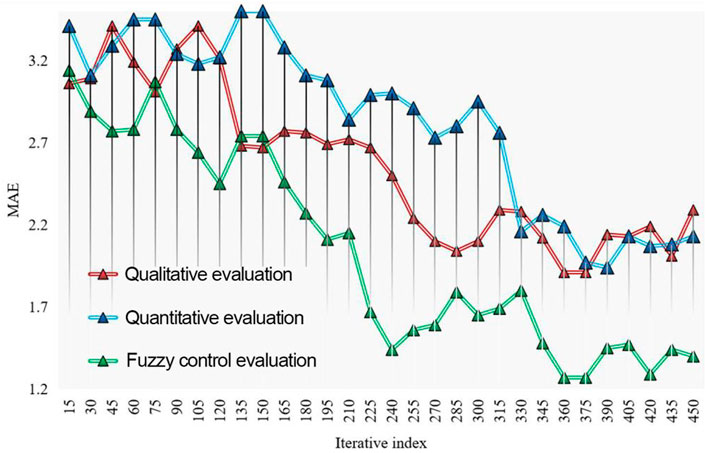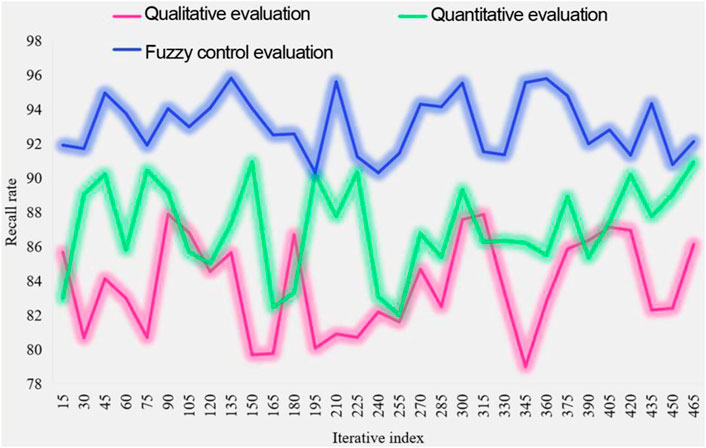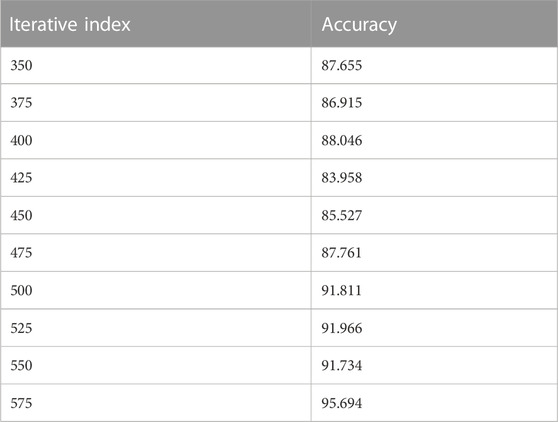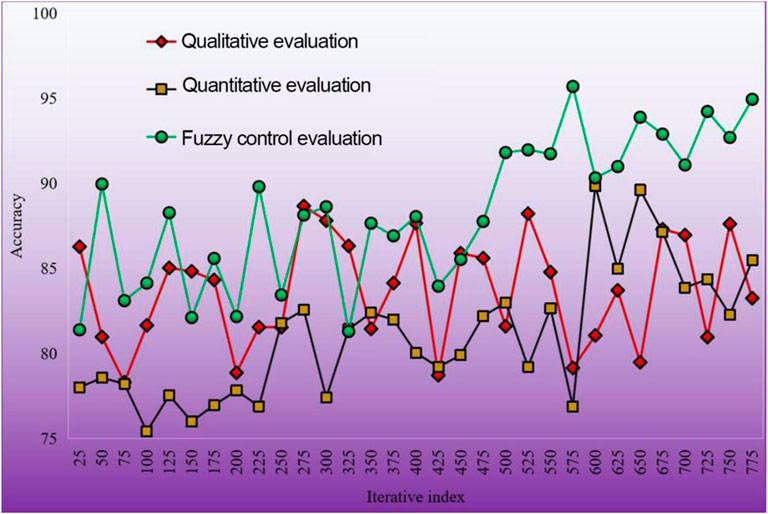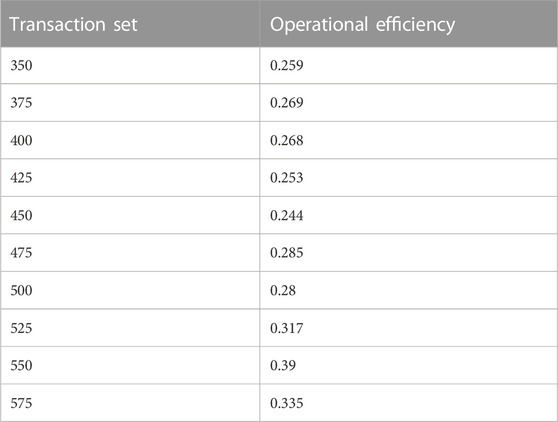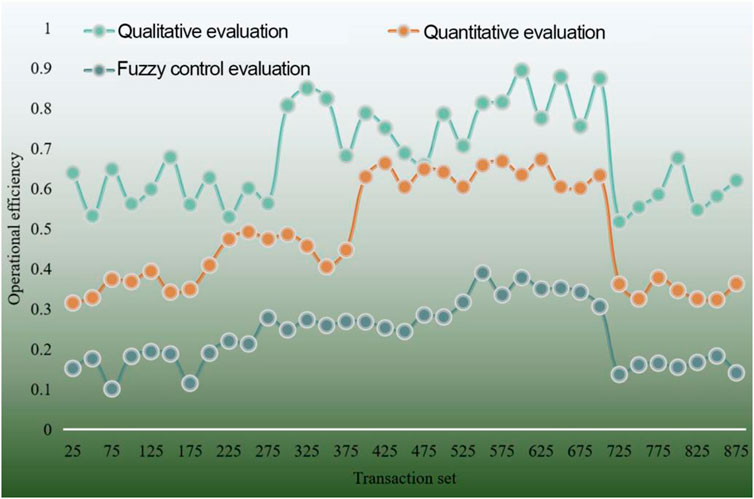- 1College of Business, Sias University, Zhengzhou, China
- 2College of Finance and Information, Ningbo University of Finance and Economics, Ningbo, China
Background: Under the guidance of carbon peak and carbon neutral targets, China’s economic development is facing unprecedented challenges. It is of great strategic significance and value to study the integrated development of regional low-carbon economy. The harmonious development of Beijing-Tianjin-Hebei (Beijing-Tianjin-Hebei) has become a national strategy, and its importance is prominent.
Objective: To promote the regional economic integration of Beijing-Tianjin-Hebei is the top priority of promoting the development of Beijing-Tianjin-Hebei integration at present, and is the key to achieving the coordinated development and mutual benefit of Beijing-Tianjin-Hebei.
Methods: In this context, this paper studies the fuzzy control evaluation algorithm of regional economy based on SDM model. Realized the prediction of the expansion of the low-carbon economy in Beijing-Tianjin-Hebei, and put forward the development strategy of the economic integration of Beijing-Tianjin-Hebei. The ranking of regional competitiveness of fuzzy control evaluation method is in line with the reality of today’s economic expansion. The application of fuzzy rules improves the speed, accuracy and objectivity of evaluation.
Results: The final experiment shows that the accuracy of the algorithm is very high, reaching 95.14%. In addition, the algorithm has higher efficiency and better performance. The fuzzy control evaluation algorithm of regional economy can better predict the economic growth of Beijing, Tianjin and Hebei.
Conclusion: Propose the development strategy of Beijing-Tianjin-Hebei low-carbon economic integration to further promote the development of Beijing-Tianjin-Hebei integration and promote the adjustment and optimization of China’s economic structure.
1 Introduction
Based on the connotation and characteristics of regional low-carbon economic integration, the strategic implications of regional low-carbon economic integration development are summarized. It mainly includes the strategic choice of regional energy transformation, the strategic innovation of regional system integration, the strategic measures of regional economic development mode transformation and the strategic guarantee of regional new business model construction. By doing a good job in top-level design, accelerating the development of new energy industry, building a new industrial development mode, and giving play to the effect of maintaining and increasing the value of carbon assets. Build carbon neutral demonstration parks and promote diversified cooperation among regions, promote coordinated regional development and high-quality industrial development, promote the construction of a beautiful China, and help achieve the goals of carbon peak and carbon neutrality. Decades of development have greatly improved China’s economic and social outlook. However, it is precisely because of the rapid economic expansion that the inherent differences in transportation, resources, culture and economic base among regions have been further enlarged, and the imbalance of regional economic expansion has become more and more prominent. Located in the heart of the Bohai Rim in China area of Northeast Asia, Jing-Jin-Ji is the largest and most dynamic area in northern China, attracting more and more attention from China and even the whole world. Chai et al. measured the carbon entropy and carbon emission efficiency of 25 industries in Beijing Tianjin Hebei region from 2000 to 2015 by building a carbon entropy model and a total factor industrial carbon emission efficiency evaluation model. The research shows that: (a) The priority industries in Beijing Tianjin Hebei region are expanding, the regional competitiveness of moderately developed industries is improving, and the proportion of industries that restrict development is significantly decreasing. (b) The spatial distribution of the three types of industries presents a concentric ring pattern, with priority industries as the core, moderate industries as the main, followed by industries with limited development. (c) The situation of medium and efficient industries has improved, while that of inefficient industries has declined (Chai et al., 2021). In order to further study the current situation and development trend of low carbon construction in Beijing, Tianjin and Hebei, in the absence of direct data on carbon emissions. The research team searched the China Statistical Yearbook, and then converted the final energy consumption data into GDP, population carbon emissions and living consumption of the three major industries in Beijing, Tianjin and Hebei from 2005 to 2015. On this basis, Zhang et al. analyzed the change trend of carbon emissions in Beijing Tianjin Hebei region and put forward some problems. Finally, the corresponding suggestions, solutions and countermeasures are put forward for the existing problems (Zhang et al., 2018a). Xue et al.'s improvement of carbon emission efficiency (CEE) will promote the development of green low-carbon economy in Beijing Tianjin Hebei region of China. This paper uses the unexpected output EBM model to measure the city level CEE in BTH from 2007 to 2016. This paper analyzes the spatial distribution characteristics and evolution laws of Central and Eastern Europe from the overall and local aspects, and verifies the influencing factors of Central and Eastern Europe by using the spatial quantile regression model (Xue et al., 2022). Therefore, it is need to grasp the present situation of industrial development in Jing-Jin-Ji, and to understand the development trend of leading industries in Jing-Jin-Ji and the interrelated results.
China will vigorously support green and low-carbon energy development in developing countries. Achieving carbon peaking and carbon neutralization is an inherent requirement of China’s high-quality development, a strategic choice to practice the idea of ecological civilization, and a broad and profound economic and social systematic change. China is faced with the huge challenge of carbon emission reduction. It is necessary to explore a new mode and path for the integrated development of regional low-carbon economy, enhance the systematicness, integrity and synergy of carbon emission reduction, and accelerate the in-depth emission reduction. With the transformation of China’s economic development model, various industries in Beijing Tianjin Hebei (BTH) region have put forward the requirement of high energy conservation and emission reduction (ECER). However, as an important indicator of achieving sustainable low-carbon development, the rebound effect of energy consumption has not been fully investigated in industrial enterprises in this field. Li et al. (2018) uses an alternative estimation model based on the neoclassical economic theory to measure the energy rebound effect of industrial enterprises in BTH. Carbon dioxide mainly comes from industrial economic activities. Industrial structure optimization is an effective way to reduce carbon dioxide emissions. Gu et al. uses the panel data of 13 cities in Beijing Tianjin Hebei urban agglomeration from 2006 to 2019 to calculate the industrial structure rationalization index using the Theil index. Use the proportion of industrial added value to calculate the industrial structure upgrading index. Through the construction of STIRPAT model, this paper quantitatively analyzes the impact of industrial structure rationalization and upgrading on carbon emissions (Gu et al., 2022). Regional economic integration refers to the elimination of trade barriers by different spatial entities, and the realization of free flow, cooperation and complementarity in space, industry and market. It is the unity of state and process, means and purpose. Under the guidance of regional strategy, regional coordination is strengthened through regional planning and policies, and the spatial pattern of social and economic activities is optimized (Rahul, 2016). On a larger scale, regional economic integration is no longer limited to the union between regions or cities within a country (Yu, 2020). Regional economic integration is one of the remarkable characteristics of current economic expansion, and the construction of regional metropolitan areas represented by Jing-Jin-Ji has great influence on international metropolitan areas. Therefore, this article will model and analyze the influencing factors of Jing-Jing-Ji cluster on regional economic integration, which has certain practical significance.
Hu et al. studied the different impacts of coordinated development of Beijing Tianjin Hebei region on industrial energy and pollution intensity based on the difference method (DID) and quantile DID method. The panel data covers the industrial energy consumption and three kinds of wastes, namely industrial wastewater, sulfur dioxide and dust emissions, in all 13 cities in BTH and 17 cities in Henan Province from 2007 to 2017. The research results show that, in addition to the dust pollution caused by the traffic integration in BTH, China should pay more attention to the green industrial relocation from Beijing to Hebei, and strengthen the coordinated environmental supervision while maintaining the interests of enterprises (Hu et al., 2020). Liu et al. used principal component analysis, entropy evaluation method and coupling coordination model (CCDM) to assess the coordination level between carbon and air quality mitigation in 34 low carbon pilot cities in China. We also use three case studies to illustrate the formation of mechanisms and policies that lead to different coupling patterns at the local level. We found that most pilot cities showed a moderate degree of coupling and coordination between low-carbon development and air quality. The results show that most low carbon pilot cities have relatively high scores in low carbon development (Liu et al., 2021). Due to the special conditions of geographical proximity, the economy of Jing-Jin-Ji is inextricably linked, and this inherent permeability and interdependent economic relationship has incomparable advantages in improving foreign competitiveness. The economic development characteristics of Beijing Tianjin Hebei region: the economic core areas with different levels have been formed with Beijing as the center. The economic development of the Beijing Tianjin Hebei Economic Zone has maintained a relatively high speed, but there are large differences between different regions. Taking the county economy of Beijing Tianjin Hebei as the research unit, this paper attempts to explore the time concentration distribution characteristics and spatial correlation of the county economic development of Beijing Tianjin Hebei under the background of the coordinated development of Beijing Tianjin Hebei, and reveals the gap between Hebei Province and Beijing Tianjin.
In the current context, Beijing Tianjin Hebei regional integration should not only accelerate the pace of regional coordinated development, but also re-examine itself and recognize its advantages and disadvantages. This paper analyzes the reality and feasibility of Beijing Tianjin Hebei integration, mainly discusses the influencing factors of Beijing Tianjin Hebei cluster on regional economic integration based on SDM model, and carries out modeling and analysis. The main contributions are as follows:
1. Construct a regional economic competitiveness index system with dual spatial integration characteristics. A workable regional economic evaluation system has been formed.
2. Propose the economic integration strategy of Beijing Tianjin Hebei region. It not only makes the basic data accurate and complete, but also makes the relevant models easy to systematize. It provides a way for the study of other regional economic integration.
3. The experimental results show that the fuzzy control evaluation algorithm of regional economy can better predict the economic growth of Beijing, Tianjin and Hebei. The study is expected to further promote the integrated development of Beijing, Tianjin and Hebei, and promote the adjustment and optimization of China’s economic structure.
This paper studies the fuzzy control evaluation algorithm of regional economy based on SDM model, realizes the prediction of low carbon economic expansion in Beijing Tianjin Hebei, and puts forward the development strategy of economic integration in Beijing Tianjin Hebei. Section 1 describes the connotation and characteristics of regional low-carbon economic integration, and summarizes the strategic significance of regional low-carbon integration development. Section 2 analyzes the existing research results of regional economic integration and low-carbon economy. The influence of industrial agglomeration on regional economic integration is obtained. Section 3 analyzes the economic conditions and environment of the Beijing Tianjin Hebei region, which is also an important embodiment of the diversity and unity of the construction of ecological civilization and the construction of a beautiful China. The fuzzy evaluation model of regional economy is analyzed. Section 4 forecasts and simulates the regional economic expansion of Beijing Tianjin Hebei. In this part, the fuzzy evaluation model of regional economy is used to predict the economic growth of Beijing Tianjin Hebei, and the effectiveness of the algorithm proposed in this paper is verified. Section 5 summarizes the full text. The results show that the fuzzy control evaluation algorithm of regional economy can better predict the economic growth of Beijing, Tianjin and Hebei. This study is expected to further promote the integration of Beijing, Tianjin and Hebei, and promote the adjustment and optimization of China’s economic structure.
2 Related work
The integrated development of regional low-carbon economy has rich connotation, as well as regional, systematic and collaborative characteristics. Based on the existing research results of regional economic integration and low carbon economy, this paper defines regional low carbon economic integration as a new regional development model integrating multiple (carbon technology integration, system integration, management integration, etc.) with low carbon economy as the development direction in a specific regional space. Improve energy utilization efficiency, strengthen regional coordinated emission reduction, and promote regional low-carbon zero carbon development and sustainable development. The integrated development of regional low-carbon economy is conducive to adjusting the energy consumption structure, significantly reducing carbon emissions, giving play to the role of market integration and regional coordinated emission reduction, promoting regional coordinated development, promoting high-quality industrial development, and helping build a beautiful China.
Regional ecological coordinated development is a new form of regional coordinated development aimed at building ecological civilization in the “new normal” period. The coordinated ecological development of Beijing Tianjin Hebei (BTH) region is particularly important because it is leading China’s overall coordinated development and reform. Based on the complex system theory, synergetics and the concept of ecological civilization and green development in the “new normal” period, Zhao and Zhang built a regional ecological synergy measurement model, which scientifically evaluated the dynamic evolution of BTH’s ecological synergy level from 2006 to 2018. Using econometric models, we also analyzed the welfare effect and regional heterogeneity of ecological synergy in regional development (Zhao and Zhang, 2021). Gao and Li (2021) calculated the level of industrial agglomeration by using the relevant industrial agglomeration index, and measured the regional economic integration index of the Yangtze River Delta by comprehensive assessment method. In order to better reflect the level of urbanization, the panel entropy weight method is used to weight the population, industry and area factors. Wang et al. constructs a comprehensive indicator of urbanization. The panel regression between the composite index and the average nighttime light after fusion showed a strong correlation. The accuracy test shows that the estimated value of the fusion average light calculated by the urbanization level estimation model fully represents the urbanization level (Wang et al., 2021). Jeff (2014) improved SOM algorithm and applied it to pattern classification of regional economic assessment. Li et al. established a logarithmic average divisor index model to decompose the total carbon emission increment. The carbon finance effect is divided into green credit effect and carbon trading effect, and the impact of carbon finance on carbon emissions is analyzed (Li et al., 2019). Xiao et al. discussed the environmental effect and mechanism of coordinated development of urban agglomeration. The results show that the coordinated development of Beijing, Tianjin and Hebei has a significant and sustained impact on the convergence of PM2.5 to the low level. The further mechanism identification results show that the air joint defense rules and policies in the process of Beijing Tianjin Hebei coordinated development mainly promote the convergence of PM2.5 through population and economic scale effects, structural effects and technological effects, and promote the convergence of PM2.5 to a lower direction by reducing the economic growth scale of the city itself. It is suggested to further promote the formation and development of Beijing Tianjin Hebei integration, strengthen cross regional environmental governance cooperation between local governments, and promote green growth and coordinated development of urban agglomeration (Xiao et al., 2022). The rapid economic growth in China’s megalopolis is characterized by rapid urbanization, accompanied by a series of environmental problems, ranging from extensive soil pollution to groundwater depletion. Tian et al. analyzed the interaction between urbanization and ecosystem, and reviewed the existing urban and ecosystem analysis framework. Taking the Beijing Tianjin Hebei region as an example, this paper introduces a conceptual framework to analyze the megacity region, and applies the simulation model to predict the possible interaction between urbanization and the ecological environment (Tian et al., 2019). Climate change and rapid urbanization have brought natural and human genetic interference to urban ecosystems, and damaged the sustainability and resilience of cities. The assessment of urban ecological resilience and the study of its impact mechanism are of great significance for sustainable urban management. Taking the Beijing Tianjin Hebei Urban Agglomeration (BTHUA) region of China as the research area, Shi et al. constructed an evaluation index to evaluate the urban ecological resilience and its spatial pattern by using the resilience substitutes of net primary productivity from 2000 to 2020. The evaluation index is constructed from two dimensions, including the sensitivity and adaptability of urban ecosystem, to capture the two key mechanisms of resilience, namely resistance and resilience (Shi et al., 2022). Cui and Wang (2021) put forward countermeasures and feasible suggestions for promoting the growth of Jing-Jin-Ji cooperation and regional economic integration by analyzing the current situation of Jing-Jin-Ji low carbon economic cooperation and the problems existing in regional economic integration. Li (2014) pointed out that high economic expansion should not simply pursue economic aggregate and growth rate, but should pay more attention to the harmonious growth of economy, society and environment. Hussain et al. (2022) found that the consumer price index (CPI) factors that lead to the decline of Jing-Jin-Ji market integration development level are mainly housing, clothing, transportation and communication.
On the basis of summarizing the existing research results, this article studies a fuzzy control assessment algorithm of regional economy combined with SDM model, realizes the prediction of Jing-Jin-Ji low carbon economic expansion, and then puts forward the development strategy of Jing-Jin-Ji low carbon economic integration. In order to further promote the integrated growth of Jing-Jin-Ji and promote the adjustment and optimization of China’s economic structure.
3 Methodology
3.1 Analysis of regional economic conditions and environment in Jing-Jin-Ji
Different regions have different resource endowments and regional characteristics. The difference of resource endowment and location determines that different regions have different industrial structure, industrial layout and development space. Secondly, the difference in economic infrastructure and infrastructure between regions is an important factor affecting the development of low-carbon economy. If a region has a good economic foundation and complete infrastructure, it can better promote the development of low-carbon economy and be conducive to the construction of ecological civilization. Thirdly, there are differences in human environment between regions. This requires selecting appropriate low-carbon economic development path according to different cultural characteristics. Regionality is a prerequisite and basic guarantee for the differentiated development of low-carbon economy in different regions, and also an important embodiment of the diversity and unity of ecological civilization construction and the construction of a beautiful China.
The Beijing Tianjin Hebei region has great potential for emission reduction. It is particularly important to finance energy conservation and emission reduction through technological innovation and optimization transformation of the real economy. Therefore, we should seize the opportunity to vigorously develop carbon finance, establish carbon finance innovation system and mechanism, and cultivate a multi-level carbon trading market system. Carry out the innovation of financial activities of low-carbon financial derivatives such as low-carbon swaps, forwards, futures trading, low-carbon securities, low-carbon futures, funds, etc. It has become the most important work of the carbon market in the process of Beijing Tianjin Hebei integration. With the acceleration of global economic process, regional economic integration has become the leading force to promote regional economic expansion. Regional economic integration refers to the stage of market integration between different spatial economic entities in order to obtain benefits such as production, consumption and trade (Ye, 2014). Including the gradual evolution from product market and factor markets to the unification of economic policies. Jing-Jin-Ji is the heart of the northern region, and its regional economic expansion is the core of China’s northern economy. The regional economic integration of Jing-Jin-Ji can not only promote the economic growth of Beijing, Tianjin, Hebei and other provinces and cities, but also reflect the significance in guiding the future economic growth of surrounding areas and even enhancing the overall national strength of the whole country (Liu and Wang, 2016). Compared with the divergent and uniform distribution pattern of the Yangtze River Delta and the Pearl River Delta, Beijing and Tianjin are located in the hinterland and edge of Hebei Province respectively. Geographically, this kind of mega-city exists in one region at the same time in three provinces and cities, and it is rare even in the history of regional economy in the world. From the perspective of actual economic expansion, only GDP, total retail sales of social consumer goods and total investment in fixed assets of Jing-Jing-Ji cluster are close to the “Pearl River Delta” and lag behind the “Yangtze River Delta”. The total import and export volume and the actual utilized foreign capital account for 13% and 18% of the national proportion, and the total volume is less than half of the Yangtze River Delta and Pearl River Delta. The influence mechanism of industrial agglomeration on regional economic integration is shown in Figure 1.
The growth of Jing-Jin-Ji low carbon economic integration is not only related to the long-term growth of its own economy, but also of great significance for promoting the harmonious growth of the whole country and improving the regional economic integration mechanism of China (Zhang et al., 2018b). Among them, the gathering of high-tech industries plays a more and more important role in improving industrial structure, coordinating industrial cooperation and development, and improving regional innovation power. All regions regard the growth of high-tech industries as the primary task, and in the final analysis, it is to develop the economy. Beijing is the national political center, cultural center and the engine of knowledge economy development; Tianjin is an important industrial and commodity base; Hebei province has unique natural resources and a relatively complete industrial system, and has the most complete natural endowment and economic foundation for developing regional economic integration. No matter from the scope of regional cooperation or the rational allocation of resources and production factors, the formulation of Jing-Jin-Ji integration is more appropriate. In the Jing-Jin-Ji, the coordinated economic growth of the Bohai Rim region has become increasingly prominent. It is need to strengthen the communication and convergence of coordinated development in strategic planning, industrial development, policies and regulations, deepen, infiltrate and integrate regional industrial specialization, and promote the formation of high-end, high-quality and high-tech industrial structures. However, there are still some problems to be solved in the stage of regional economic integration in Jing-Jin-Ji: obvious differences in regional economic expansion in Jing-Jin-Ji, lack of industrial division and cooperation, irrational industrial structure, lagging growth of regional factor markets, and market barriers still exists. Therefore, a correct understanding of the present situation of regional economic integration in Jing-Jin-Ji is of great significance for promoting the growth of Jing-Jin-Ji integration (Lin and Meng, 2020). It is obviously not scientific to evaluate the level of economic expansion in a historical period only based on the clustering results of a certain time. To seek further development and coordinate regional imbalances, China should also learn from past experience. In addition, Jing-Jin-Ji is connected by mountains and rivers, and there is also a foundation for integrated development inside. Therefore, it can be said that the harmonious growth of Jing-Jin-Ji integration has both external impetus and internal motive force.
3.2 Fuzzy assessment model of regional economy
To evaluate the coordinated development system of Beijing Tianjin Hebei region, the focus is to extract specific manifestations from the complex relationship. That is to find the main factors influencing the statistical monitoring of the coordinated development of Beijing, Tianjin and Hebei. In addition, it is necessary to take full account of the independence of each factor and maintain a clear hierarchy and interdependence of each factor. Because the coordinated development of regional systems is not only an economic problem, but also a deep-seated social and ecological problem. Therefore, the target level is the level of regional coordinated development, and the criterion level is composed of economic subsystem, social subsystem and ecological subsystem. The economic subsystem is mainly reflected in three aspects: economic level, economic structure and economic extroversion: the social subsystem is measured in terms of population development, science and education level and infrastructure construction; the ecological subsystem is measured in terms of resource utilization and environmental protection. On the basis of the principle of operability, the indicator layer selects some relatively typical eigenvalues that can cover the indicator system and strives to reflect the degree and problems of the collaborative development process. The systematicness of the integrated development of regional low-carbon economy mainly refers to the integration of technology, system and management, and the deep integration of each other, which constitutes a unique spatial ecosystem. First, technological innovation is the basis and premise for the integrated development of low-carbon economy, and also the basis for achieving carbon peak and carbon neutralization. Only technological innovation can bring about new ways of production and life, and promote the fundamental change of production relations. The economic growth of a region can not be separated from the support of industry. How to promote the harmonious growth of Jing-Jin-Ji industries and improve the industrial integration level of Jing-Jin-Ji is of great significance to promote the regional economic integration of Jing-Jin-Ji. In fact, the inter-regional input-output technology reflect the significance in analyzing the input-output relationship among different regions, but it needs a large amount of survey data and systematic estimation, and its analysis results are mostly not ideal because of its big assumptions. This article studies the regional economic integration of Jing-Jin-Ji, so it is need to study Jing-Jin-Ji as a whole region.
SDM (Supervised Descent Method) is a Supervised Descent method, which is a Method to solve non-linear Least Squares (NLS) problems. The gradient descent direction is learned from the training data and the corresponding regression model is established, and then the gradient direction is estimated using the obtained model. Fuzzy cluster analysis is a mathematical method to classify things fuzzy according to certain requirements when the boundaries between things that need to be classified in mathematical analysis are blurred. Let the set of
The characteristic data of each sample is expressed as:
The fuzzy relationship between samples can be established by calculating the similarity coefficient, correlation coefficient, distance or other quantities representing similarity between samples, and written in matrix form. Namely:
This fuzzy relationship is reflexive (
According to the fuzzy comprehensive assessment and regional competitiveness assessment index system, the assessment model is established. In order to obtain an optimal fuzzy classification, a classification criterion is needed, the objective function is defined as the weighted distance between the sample and the cluster center, and the weighting coefficient is the
Among them,
Where
Industrial agglomeration, industrial division of labor and economies of scale are the dynamic effects of regional economic integration. New spatial economics, new international trade theory and industrial agglomeration theory show that the free flow of factors caused by regional economic integration plays a key role in forming industrial agglomeration and improving regional competitiveness. After establishing the scope of index screening, the principle of index screening should be considered. Due to the complexity and diversity of socio-economic indicators, the following principles must be followed when selecting indicators: (1) Objectivity. (2) representativeness. (3) Comprehensiveness. (4) Independence. (5) Comparability. (6) Availability. (7) Scientific. Because the core elements of regional competitiveness should be based on regional specialization economy and learning effect, the core elements of regional competitiveness can be decomposed into three secondary indicators: trading awareness, trading behavior and trading means. The auxiliary elements of regional competitiveness are divided into three indicators: government management ability, the relationship between government and enterprises, and the degree of regional openness. Through the analysis of the history and general situation of the transformation of labor employment structure in Jing-Jin-Ji, and the relationship between labor employment growth and economic growth, this article finds that from the long-term trend, with the growth of economy, the labor force in the primary industry will continue to decline. The labor force in the secondary and tertiary industries is constantly rising; The structure of the labor force gradually tends to be reasonable. In this article, the “time distance” between the two places is used to replace the economic distance between cities in Jing-Jin-Ji urban agglomeration, that is, the time it takes for the two cities to travel in a normal way. Therefore, the function used to express the “economic distance” between cities in Jing-Jin-Ji is as follows:
Among them, the “economic distance” between Jing-Jin-Ji cities is represented by
Two groups of deviation variables
If the meaning of the error of each objective of the original problem is different, then the linear weighted sum of the absolute value of the error can be found, that is:
Where
The weighted mathematical model of goal programming is:
For the missing index values, this article considers the cluster analysis of the complete index data of other provinces and cities first, and then classifies them into the nearest category by the nearest neighbor discriminant method according to the indexes that are not missing. In this article, a wide range of assessment indexes: MSE (Mean squared error), RMSE (Root mean square error) and MAE (Mean absolute error) are used to test and analyze the algorithm. Here are the specific formulas of these four indicators:
Where
4 Result analysis and discussion
4.1 Prediction and simulation of regional economic expansion in Jing-Jin-Ji
With the help of Kernel density estimation and exploratory spatial data analysis, this paper discusses the space-time characteristics and evolution trend of per capita GDP in 157 counties in Beijing Tianjin Hebei region from 2010 to 2017. If enterprises want to achieve sustainable development under the rigid constraints of carbon peaking and carbon neutralization, they must meet the latest requirements of carbon emission reduction and improve the value of carbon assets. Thirdly, institutions of higher learning and scientific research institutions have the advantages of talents and technology to provide technical support and intelligent support for the integrated development of regional low-carbon economy; Financial institutions can give play to the financial attribute of carbon, expand the scale of investment and financing, and promote the coordinated development of their industries. The continuous expansion of population will exert great pressure on the growth of the whole society and even the whole regional economy, directly affecting the sustainable growth of population and economy, and thus related to the implementation of the strategy of taking the lead in realizing modernization. Therefore, accurately predicting the population size of Jing-Jin-Ji in the next few years can provide a scientific basis for regional economic expansion decisions and accelerate the growth of regional economy. In addition, the CPI is an economic index that reflects the change of a country’s consumer level, and it can indirectly reflect the price change of consumer goods purchased by households in China. In this section, the fuzzy assessment model of regional economy is used to predict the growth of Jing-Jin-Ji economy, and the effectiveness of the algorithm proposed in this article is verified. The errors of this algorithm are shown in Table 1.
The development samples of Beijing Tianjin Hebei region were sampled by random sampling without duplicate samples. Now the algorithm in this article is compared with other algorithms, and the error of the algorithm is analyzed. Firstly, 450 samples were randomly selected, and several error indexes of different algorithms were drawn respectively. The MSE comparison of different algorithms is shown in Figure 3. RMSE comparison of different algorithms is shown in Figure 4. The MAE comparison of different algorithms is shown in Figure 5.
From the data analysis in Figures 3–5, this paper studies the results of regional economic evaluation using SDM model. The analysis results of SDM model show that economy and energy are the causes of environment. Economic development has its own inertia, and energy drives economic development; economic, energy and environmental variables are interrelated in space. It is necessary to properly handle the solid waste in time and be alert to the pollution caused by waste gas and water. Compared with other algorithms, the data results of MSE, RMSE and MAE of this algorithm are impressive. The algorithm has small error and good performance.
In this article, in order to eliminate the error of distance measurement caused by index correlation, several irrelevant factors must be summarized from the data, which requires factor analysis of the data. Before factor analysis, the data should be standardized to eliminate the influence of index dimension and magnitude. In this article, the standard score method is selected to standardize the data. After the experiment, the recall rates of different models are compared as shown in Figure 6. Comparison of F1 values of different models is shown in Figure 7.
In this article, the input-output model can be used to make various investment-related calculations, simulate investment policies, and provide scientific basis for formulating investment policies. The fund occupancy matrix table and the fund occupancy coefficient need to be solved. When building a dynamic input-output model, the fund occupancy matrix and fund occupancy coefficient are another important tool to establish the dynamic relationship between investment and total output. A dynamic input-output model can also be established to directly link investment with production. This requires the model to have certain accuracy. Table 2 and Figure 8 show the comparison of accuracy of different models.
According to the above analysis results, when the training times are reached, the training is terminated. It is found that the accuracy of this algorithm is higher than other algorithms. In fact, fuzzy control rules are a set of multi-conditional statements, which can be expressed as fuzzy relations from the input variable Universe to the output Universe. The fuzzy control rules in this article consist of 28 sentences, which express the fuzzy relationship between core competitiveness elements and auxiliary competitiveness elements to regional competitiveness. The fuzzy control assessment of regional economy is applicable to the assessment of regional economic growth of various economic regions, provinces and cities with rapid growth of network economy. The running efficiency of different algorithms is shown in Table 3 and Figure 9.
In order to verify the reliability of the method, many experiments are carried out in this section. The final experiment shows that the accuracy of the proposed algorithm is high, reaching 95.14%. Moreover, the algorithm has higher efficiency and better performance. The results show that the fuzzy control assessment algorithm of regional economy can well predict the growth of Jing-Jin-Ji economy.
On the whole, the commonness is that the spatial distribution of per capita GDP in the counties of Beijing, Tianjin and Hebei shows a high concentration with Beijing, Tianjin, Tangshan and Langfang as the core. The county economic growth in the Beijing Tianjin Tangshan region is still dominant, and the spatial pattern has not changed for many years. And the counties with high and low concentration are mostly distributed around the Beijing Tianjin Tangshan area, showing a typical “center periphery” spatial structure. The spatial agglomeration pattern of most counties in central and southern Hebei is not significant, and the radiation and driving role of Shijiazhuang as the provincial capital city is not significant. The economic growth pole that radiates the central and southern Hebei has not been formed, and the positive spatial spillover effect on the surrounding areas is not significant. The spatial pattern of low and low concentration areas is relatively stable. On the one hand, it is affected by its own economic foundation, resource endowment, location conditions and other factors. On the other hand, it is also related to the rapid development of the surrounding county economy. In general, the economic growth among counties in Beijing, Tianjin and Hebei is still uneven, and the gap between counties in Hebei Province and Beijing and Tianjin is still large. The spatial spillover pattern with Beijing Tianjin Tangshan region as the core and spreading to the periphery still appears. As the provincial capital, Shijiazhuang has not yet formed a space spillover to the surrounding areas, and it still needs a long way to become the third pole of economic growth in Beijing, Tianjin and Hebei.
4.2 Jing-Jin-Ji low carbon economic integration strategy
Technological innovation is the forerunner and prerequisite for the integrated development of regional low-carbon economy, among which regional system integration is one of its development trends. On the basis of technological innovation, based on the innovation and breakthrough of single carbon emission reduction technology, such as carbon capture technology, carbon utilization technology, etc., regional system integration of multiple technologies is gradually developed, which provides the basic conditions for the integrated development of regional low-carbon economy. While forming technology integration, it also forms system integration, management integration, etc. to realize the integrated development of regional low-carbon economy. After the overall regional planning forecast is completed, the specific implementation is the problem of regional coordinated development. Regional coordinated development is a complex social system engineering. On the basis that all parties in the region have the same Scientific Outlook on Development, it is the primary task of regional coordinated development to determine the development countermeasures. How to base on the actual situation of Jing-Jin-Ji, focus on the requirements of future development, and realize coordinated development in all aspects of spatial integration, industrial integration and market integration is an important breakthrough for Jing-Jin-Ji to upgrade its development level and level in the future. The experimental results in the previous section show that the fuzzy control assessment algorithm of regional economy proposed in this article can well predict the growth of Jing-Jin-Ji economy. Based on the results of the model’s prediction and simulation of Jing-Jin-Ji low carbon economic expansion, this section puts forward some suggestions on the development strategy of Jing-Jin-Ji low carbon economic integration, as follows:
(1) Jing-Jin-Ji is a community of interests, and it was formed under the conscious and organized guidance of the governments of the three places. Therefore, it is necessary for the three governments to make unified planning and deployment for the future growth of Jing-Jin-Ji. The specific planning will play a positive role in promoting the regional economic growth of Jing-Jin-Ji because of the implementation and formulation of the strategy, which is the need of enriching the people and strengthening the region, the major problem facing Jing-Jin-Ji, and the need of ensuring the rapid growth of the region.
(2) To realize regional economic integration, it is need to integrate the development goals of each region and form a consensus on the goals. The goal is to realize the equalization of basic public services in Jing-Jin-Ji, and pursue social equity. Among them, improving the consciousness of changing the appearance of economically backward areas is the foothold to solve the problem of unbalanced regional economic expansion; Strengthening opening to the outside world is an important way to solve the problem of regional economic imbalance; Strengthening the economic exchanges among different regions is the catalyst to realize the coordinated development among regions.
(3) We must fundamentally solve the contradiction between economic expansion and ecological environment, realize the ecological transformation of economic expansion, and change the mode of economic expansion is the key. In addition, in order to break the geographical division, it is need to establish a unified and open human resources market and an open human resources market system in Jing-Jin-Ji.
(4) The economic growth of Jing-Jin-Ji should also be included in the long-term planning of national economic expansion, and this area should be considered as an economic whole. Although the effect of economic expansion will not be too obvious in a short period of time, its development direction should at least meet the general requirements of “Theory of Three Represents” and building a well-off society in an all-round way, and promote multi-level alliance to seek common development.
(5) Finally, in order to adapt the informatization construction to the economic expansion, the state needs to actively adjust the informatization development strategy; Increase investment, improve policy guarantee and other measures, promote the “leap-forward” growth of informatization, and promote the growth of regional economic integration in Jing-Jin-Ji.
(6) According to the requirements of the state, the development differences of cities in the Jing-Jin-Ji should be clearly defined, and the advantages of cities in each region should be complementary, mutually beneficial and win-win and coordinated. Give full play to the advantages of capital resources and talent information; Plus Tianjin’s port advantages and industrial development advantages; Combining with the own conditions of manufacturing industry and labor force in Hebei Province, we should form a reasonable division of labor, define the development orientation of the three places, and form a complete economic expansion zone.
The carbon emissions of energy consumption in Beijing, Tianjin and Hebei have continued to increase with the expansion of economic scale, and they have not yet been completely decoupled. Hebei’s higher carbon emission growth rate than Beijing and Tianjin hinders the rise of the level of coordinated regulation. Energy intensity and industrial structure upgrading synergy both curb carbon emissions in Beijing, Tianjin and Hebei. Capital efficiency promotes carbon emissions in Beijing, while curbing carbon emissions in Tianjin and Hebei. In addition, labor productivity is an important intermediary factor in Beijing and Hebei, and economic growth is an important intermediary factor in Tianjin. This shows that the supply factors in Beijing, Tianjin and Hebei indirectly affect carbon emissions mainly by affecting labor productivity and per capita GDP. The rapid growth of labor productivity is not conducive to controlling the peak time of Beijing Tianjin Hebei. Regulating the rise of capital efficiency is an important path to improve the level of coordinated emission reduction in Beijing Tianjin Hebei. It is not only conducive to reducing carbon emissions in the three regions, but also can fill the gap in emission reduction. The need to improve energy efficiency and adjust the scale and flow of capital is an important path for Beijing and Hebei to achieve high-quality carbon peak.
5 Conclusion
The comprehensive growth of Jing-Jin-Ji urban agglomeration has become a national strategy, and its importance is self-evident. At present, the most important thing to promote the integrated growth of Jing-Jin-Ji is to promote the regional economic integration of Jing-Jin-Ji. Based on this, this article studies a fuzzy control assessment algorithm of regional economy combined with SDM model, and analyzes the influencing factors of Jing-Jing-Ji cluster on regional economic integration. Moreover, this article constructs a new index system of regional economic competitiveness with dual spatial integration characteristics, and gives a fuzzy assessment method and control rules after widely collecting statistical data and soliciting expert opinions, thus forming an operational regional economic assessment system. With this model, the regional economic expansion forecast of Jing-Jin-Ji is realized, and then the regional economic integration strategy of Jing-Jin-Ji is put forward. The establishment and application of Jing-Jin-Ji low carbon economic integration model is a scientific exploration. It not only makes the basic data accurate and complete, but also makes the relevant models easy to systematize, and enables scientific methods to be based on reliable data. It ensures the advanced research methods and the feasibility of the research results, and provides a way for the research of other regional economic integration. The final experiment shows that the accuracy of the proposed algorithm is high, reaching 95.14%. Moreover, the algorithm has higher efficiency and better performance. The results show that the fuzzy control assessment algorithm of regional economy can well predict the growth of Jing-Jin-Ji economy. This study is expected to further promote the integrated growth of Jing-Jin-Ji and promote the adjustment and optimization of China’s economic structure. It is believed that with the strengthening of Beijing’s urban functions, the further construction of Tianjin Free Trade Zone and the expansion of the new district, Jing-Jin-Ji urban agglomeration is expected to become a brand-new high-quality economic growth pole in the north.
The system proposed in this paper still needs to be improved step by step, and is subject to the continuous test of regional economic practice. Although the evaluation time of each batch of fuzzy control is only a few seconds, more decision groups are still needed to realize it. The direction to be improved in the future mainly includes: the realization of online evaluation and the realization of group decision support system. Expansion of evaluation and weighting method library. Construction of template library; How to realize automatic knowledge acquisition. For example, using artificial neural network, genetic algorithm support vector machine and other methods.
Data availability statement
The original contributions presented in the study are included in the article/supplementary material, further inquiries can be directed to the corresponding author.
Author contributions
LZ performed the data analysis, HW performed the formal analysis and the validation, YX wrote the manuscript. All authors approved its submission to the journal.
Funding
This work was supported by MOE (Ministry of Education in China) Project of Humanities and Social Sciences: Research on the Organization Mode and Governance Mechanism of Shared Recycling Recreation (No. 20YJC630241); The Natural Science Foundation of Zhejiang Province: Research on Organization Model and Support System of Supply and Demand Network for Recycling and Remanufacturing (No. LY20G030025); National Social Science Foundation of China: Research on Recycling and Remanufacturing Network Organization and its Governance under Sharing Economy (No. 18BGL184).
Conflict of interest
The authors declare that the research was conducted in the absence of any commercial or financial relationships that could be construed as a potential conflict of interest.
Publisher’s note
All claims expressed in this article are solely those of the authors and do not necessarily represent those of their affiliated organizations, or those of the publisher, the editors and the reviewers. Any product that may be evaluated in this article, or claim that may be made by its manufacturer, is not guaranteed or endorsed by the publisher.
References
Chai, Y., Lin, X., and Wang, D. (2021). Industrial structure transformation and layout optimization of beijing-tianjin-hebei region under carbon emission constraints. Sustainability 13 (2), 643. doi:10.3390/su13020643
Cui, W. T., and Wang, S. W. (2021). Analysis on the strength of regional economic ties and network structure of Jing-Jin-Ji. Res. Technol. Econ. Manag. 2021 (004), 117–121.
Gao, D., and Li, S. (2021). A study on the coupling coordination between forestry production efficiency and regional economic development in China. For. Prod. J. 71 (1), 11–19. doi:10.13073/fpj-d-20-00045
Gu, R., Li, C., Li, D., Yang, Y., and Gu, S. (2022). The impact of rationalization and upgrading of industrial structure on carbon emissions in the Beijing-Tianjin-Hebei urban agglomeration. Int. J. Environ. Res. Public Health 19 (13), 7997. doi:10.3390/ijerph19137997
Hu, C., Hu, B., Shi, X., and Wu, Y. (2020). The roles of Beijing-Tianjin-Hebei coordinated development strategy in industrial energy and related pollutant emission intensities. Sustainability 12 (19), 7973. doi:10.3390/su12197973
Hussain, Z., Khan, M. K., and Shaheen, W. A. (2022). Efect of economic expansion, income inequality, transportation, and environmental expenditures on transport emissions: Evidence from OECD countries. Environ. Sci. Pollut. Res. 2022 (37), 29.
Jeff, Neilson (2014). Regional dynamics in a decentralised Indonesia edited by HalHill (ed.) ISEAS publishing, Singapore, 2014 Pp. 538. ISBN 978 9814 45985 3. Asian-Pacific Econ. Lit. 28 (2), 105–107. doi:10.1111/apel.12080
Li, G., Sun, J., and Wang, Z. (2018). Exploring the energy consumption rebound effect of industrial enterprises in the Beijing–Tianjin–Hebei region. Energy Effic. 12 (4), 1007–1026. doi:10.1007/s12053-018-9743-4
Li, L., Liu, D., Hou, J., Xu, D., and Chao, W. (2019). The study of the impact of carbon finance effect on carbon emissions in beijing-tianjin-hebei region—based on logarithmic mean divisia index decomposition analysis. Sustainability 11 (5), 1465. doi:10.3390/su11051465
Li, W. Z. (2014). Research on the coordination mechanism of harmonious growth of regional economy and finance in Jing-Jin-Ji. Qiuzhi 2014 (6), 3.
Lin, P., and Meng, N. N. (2020). Quality measurement and dynamic deconstruction of Jing-Jin-Ji economic expansion under environmental constraints-based on the perspective of green total factor productivity. Econ. Geogr. 40 (9), 10.
Liu, H. Z., and Wang, L. N. (2016). The impact of labor mobility on the regional economic expansion gap between Beijing and Tianjin. Popul. Econ. 2016 (2), 11.
Liu, T. L., Song, Q. J., Jiaqi, L. U., and Qi, Y. (2021). An integrated approach to evaluating the coupling coordination degree between low-carbon development and air quality in Chinese cities. Adv. Clim. Change Res. 12 (5), 710–722. doi:10.1016/j.accre.2021.08.001
Rahul, Sen (2016). China's rise and regional integration in east Asia: Hegemony or community? Asian-Pacific Econ. Lit. 30 (1), 153–154. doi:10.1111/apel.12144
Shi, C., Zhu, X., Wu, H., and Li, Z. (2022). Assessment of urban ecological resilience and its influencing factors: A case study of the beijing-tianjin-hebei urban agglomeration of China. Land 11 (6), 921. doi:10.3390/land11060921
Tian, L., Xu, G., Fan, C., Zhang, Y., Gu, C., and Zhang, Y. (2019). Analyzing mega city-regions through integrating urbanization and eco-environment systems: A case study of the beijing-tianjin-hebei region. Int. J. Environ. Res. public health 16 (1), 114. doi:10.3390/ijerph16010114
Wang, J., Liu, H., Liu, H., and Huang, H. (2021). Spatiotemporal evolution of multiscale urbanization level in the Beijing-Tianjin-Hebei Region using the integration of DMSP/OLS and NPP/VIIRS night light datasets. Sustainability 13 (4), 2000. doi:10.3390/su13042000
Xiao, Z., Li, H., and Gao, Y. (2022). Analysis of the impact of the Beijing-Tianjin-Hebei coordinated development on environmental pollution and its mechanism. Environ. Monit. Assess. 194 (2), 91. doi:10.1007/s10661-021-09720-9
Xue, L. M., Zheng, Z. X., Meng, S., Li, M., Li, H., and Chen, J. M. (2022). Carbon emission efficiency and spatio-temporal dynamic evolution of the cities in Beijing-Tianjin-Hebei Region, China. Dev. Sustain. 24 (6), 7640–7664. doi:10.1007/s10668-021-01751-z
Ye, T. L. (2014). Research on jing-jin-ji economic development strategy in the new era. Reg. Econ. Rev. 2014 (001), 138–141.
Yu, M. (2020). Comments on A Framework for regional banking regulation in ASEAN. Asian Econ. Pap. 19 (3), 126–127.
Zhang, X. B., Yu, W., Zhang, Y. L., Song, J. P., and Wang, Z. B. (2018). Spatio-temporal differentiation and influencing factors of economic growth in Jing-Jin-Ji. J. Geogr. 73 (10), 16.
Zhang, Y., Liu, L., Hu, D., and Zhang, J. (2018). Research on the current situation and countermeasures of carbon emission under the beijing-tianjin-hebei integration—based on the investigation of the current status of carbon emission in beijing-tianjin-hebei region. J. Low Carbon Econ. 7 (1), 24–34. doi:10.12677/jlce.2018.71003
Keywords: SDM model, Beijing Tianjin Ji region, low carbon economic, regional economic integration, fuzzy control evaluation algorithm
Citation: Zhu L, Wu H and Xu Y (2023) Modeling and analysis of factors affecting the integration of Beijing Tianjin Hebei low carbon economy based on SDM model. Front. Energy Res. 11:1113295. doi: 10.3389/fenrg.2023.1113295
Received: 01 December 2022; Accepted: 16 January 2023;
Published: 24 January 2023.
Edited by:
Wen-Tsao Pan, Hwa Hsia University of Technology, TaiwanReviewed by:
Nie Chen, Zhejiang Business Technology Institute, ChinaDa Meng, Shenzhen Technology University, China
Yi Cao, Hebei Finance University, China
Copyright © 2023 Zhu, Wu and Xu. This is an open-access article distributed under the terms of the Creative Commons Attribution License (CC BY). The use, distribution or reproduction in other forums is permitted, provided the original author(s) and the copyright owner(s) are credited and that the original publication in this journal is cited, in accordance with accepted academic practice. No use, distribution or reproduction is permitted which does not comply with these terms.
*Correspondence: Hua Wu, d3VodWFAc2lhcy5lZHUuY24=
 Lin Zhu
Lin Zhu Hua Wu
Hua Wu Ying Xu2
Ying Xu2